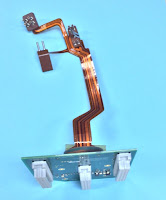 |
| Examples of air heaters (click for larger view) |
You may want to consider an inline "air process heater".
These fabricated (usually custom) electric heaters are self-contained, provide inlets and outlets, wiring, sensors to measure internal temperatures, and are available in a variety of materials.
Air Process heater provide hot air and gas up to 1000oF (540oC) with infinite control by varying the voltage and air velocity supplied.
Units are fitted with a tubing “T” for convenient power lead outlet, while larger diameters can be supplied with post terminals on the sheath for direct electrical connections.
Designs can accommodate male or female NPT threaded fittings, hose adaptors, flanges, or custom fittings to your specifications.
 |
| Typical Air Heater Construction |
- Optional stainless steel bushing.
- Ceramic coil support.
- Resistance element.
- Stainless steel sheath.
- Silver solder.
- Fiberglass insulated leads.
- Epoxy seal.
- Copper tee.
- Heliarc weld.
- Optional brass bushing.
To properly size and select an air process heater:
- Determine the volume of air or gas(SCFM) you will be heating.
- Determine temperature rise in degrees Fahrenheit(ToF).
- Calculate wattage required as follows:
- Watts = SCFM x delta-T oF / 3
Summary of Features:
- Exit air temperatures to 11000oF (540oC).
- Standard pressure rating is 80 psig at room temperature.
- May be used with recirculating air up to 250oF (121oC).
- Designed for horizontal use.
- For use with clean, dry air.
